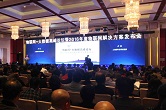Home > Photos and Videos
Wuxi New District
(wndonline.gov.cn)
Updated: 2018-06-05
The Wuxi New District (formerly known as Wuxi National Hi-tech Industry Development Zone) was founded in 1992 and underwent administrative changes in 1995, 2002 and 2005. It has six subdistricts--Wangzhuang, Shuofang, Jiangxi, Meicun, Hongshan and Xin'an.
With a total area of 220 square kilometers and a population of 600,000 (based on 2014 census), the district is currently administrating the Wuxi Hi-tech Industrial Development Zone, Wuxi (Taihu) International Technology Park, Wuxi Airport Industrial Park, China (Wuxi) Industrial Expo Park, China Wu Culture Expo Park, and International Education and Living Community.
The district is an economic engine behind opening-up of Wuxi. It is also a center of science innovation and development transformation. It has six pillar industries -- photovoltaic solar, micro-electronics, auto parts, IOT, new materials and bio-pharmaceutics.
Acclaimed as the only advanced development park in Jiangsu province at the 20th anniversary of National Torch Plan and also Jiangsu's first innovation and entrepreneurship base for overseas high-end talents, the new district has housed the national IOT innovation demonstration zone, a national innovation park, a national eco-industrial demonstration park, and a national intellectual property pilot park.
WND has ranked second in comprehensive evaluation of national development parks in Jiangsu for eight consecutive years. In 2013, its GDP was 121.3 billion yuan ($19.54 billion), revenues reached 12.22 billion yuan, and industrial output value above designated size totaled 276.7 billion yuan. With area accounting for only 4.6 percent of Wuxi, and population accounting for 6.8 percent across the city, Wuxi New District contributes 15 percent of Wuxi's gross economic output value.
The new district boasts abundant resources and development advantages, including:
1. Historical and cultural resources

The district sits near Taihu Lake, which is the place of origin of Wu Culture. It abounds in national historical and cultural resources. The district has more than 60 percent of Wuxi's Wu Culture resources, which have been discovered along the Bodu River from Meicun to Hongshan.
There are some stories such as the "Ju An Qi Mei", which tells that Liang Hong and his wife Meng Guang who treated each other with courtesy, and some simple folk customs such as "San Rang Tuan Zi" (dumplings with three types of stuffing).
The district covers three state-level 4A tourist attractions--the Hongshan Archaeological Park, Lianghong Wetland Park, and Hongshan Taibo Scenic Spot, and also a host of eco-resources such as China Stone Park and Meicun Erhu Industrial Park.
The district is aiming to become a hi-tech zone filled with culture, ecology, and environment elements.
2. Contributing to Wuxi's development

The district contributes 15 percent of Wuxi's GDP, a fifth of the city's industrial output value above designated size, more than a third of the city's paid-in foreign capital, and approximately half of the city's import and export turnover. On average, the district's GDP per unit of land is 3.3 times of that of Wuxi, industrial output value is 4.2 times of that of Wuxi, output per unit of land is 3.6 times, industrial assets investment per unit of land is 3.5 times, and total turnover of import and export per unit of land is 10 times.
In terms of technology, the district's industrial output is two times of that of Wuxi, the number of patents per 10,000 people is 3 times, and the ratio of R&D expenditure to GDP is 1.5 times. In terms of resource consumption, the district's emissions intensity per unit of GDP is only half of that of Wuxi, sulfur dioxide emissions intensity per unit of GDP is only one-tenth, and nitrogen oxides emissions intensity per unit of GDP is 3.5 percent. In terms of livelihood, the number of harmonious urban communities is 1.2 times of that of Wuxi, and the number of harmonious rural communities is 1.3 times.
3. Leader in modernization

The district has hit Jiangsu's modernization targets well ahead of other parts of Wuxi, and is a first-tier area for basic modernization in Jiangsu. More than 70 percent of residents in the district are satisfied with the district's basic modernization initiatives, according to basic modernization review by local development and reform commission and the statistics bureau in 2012, and surveys, phone interviews by the Jiangsu Poll Center, as well as other random interviews. .
The new district follows the Central Government's guidance and focuses on economic growth and efficiency and seeks for stability and innovation. To reach Wuxi's development goals, the district continues to carry out "Year of Enhanced Basic Modernization", "Year of Enhanced Project Construction" and "Year of Enhanced Work Style and Primary Organizations" activities, as part of efforts to implement its economic internationalization strategy and improve modernization. Under the guidance of the South Jiangsu Modernization Demonstration Area, Wuxi New District is continually seeking for innovation, new concepts, new competitiveness, and new scientific development.
The former Wuxi New District, now known as Wuxi Xinwu district or Wuxi National Hi-tech district, was founded in 1992 and underwent administrative changes in 1995, 2002 and 2005.
>> Read More
 IoT competition concludes in WND
IoT competition concludes in WND IoT industry senses an opportunity in China
IoT industry senses an opportunity in China